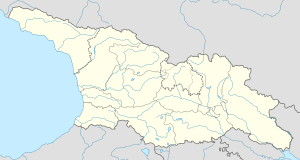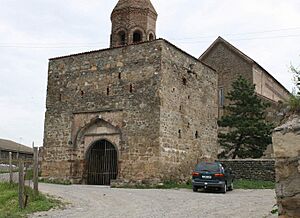Urbnisi facts for kids
Quick facts for kids
Urbnisi
ურბნისი
|
|
|---|---|
| Country | |
| Region | Shida Kartli |
| Municipality | Kareli |
| Elevation | 640 m (2,100 ft) |
| Population
(2014)
|
|
| • Total | 1,109 |
| Time zone | UTC+4 (Georgian Time) |
Urbnisi (Georgian: ურბნისი) is a village in Georgia. It is located in the Shida Kartli region, within the Kareli area.
Long ago, Urbnisi was a very important city. It was part of ancient Iberia. This is what Georgia was called by the Greeks and Romans. Urbnisi was the second most important city in Iberia, after the capital city of Mtskheta.
Contents
Ancient History of Urbnisi
Urbnisi sits on the high left bank of the Mtkvari river. People have lived here for a very long time.
Early Settlements
Archaeologists have found proof that people lived in Urbnisi as far back as 3000 BC. They discovered special buildings made of wattle and daub. This means they used woven branches covered with clay. These buildings were round or square with rounded corners. They had a window in the roof and a central pillar to hold them up.
Growth into a City
By the 4th century BC, Urbnisi had grown into a busy city. It was a center for trade and culture. In ancient graves, archaeologists found beautiful items. These included gold, silver, pottery, glass, and bone objects. Some were made locally, and others were brought from other places.
City Defenses and Attacks
Urbnisi was a large city, surrounded by a wide stone wall. Ruins of a fortress, fancy baths, and old religious sites have been found. There was even a Jewish temple, showing how important the city was.
Evidence like burned buildings and round catapult stones suggests the city was attacked. It might have been under a siege and then taken over around the 3rd century BC.
Urbnisi and Christianity
A new chapter for Urbnisi began when Iberia became a Christian country. Urbnisi grew into a major center for Georgian Orthodox culture. It also became the home of a bishop.
Fortifications and Invasions
From the 6th to 7th centuries, strong defenses were built around the city. These included 25 towers. However, these defenses could not stop the Arab commander Marwan. He captured the city in the 730s. After this invasion, Urbnisi became a small village. But the Urbnisi Cathedral of St. Stephen continued to be an important church.
Urbnisi Cathedral
The Urbnisi Cathedral is a large church built between the 6th and 7th centuries. It is a three-nave basilica, which means it has a main aisle and two side aisles. The church was rebuilt two times, in the 10th and 17th centuries. It has twelve strong pillars that support its structure.
There are many old writings on the walls of the cathedral. These are believed to be examples of the 5th–6th-century Georgian alphabet.
The Bell-Tower
In 1706, a bell-tower was added to the west side of the church. An inscription on its western wall says that King Vakhtang VI and Queen Rusudan ordered its construction.
The bell-tower has two parts. The bottom part is a strong, cube-shaped base. The top part is the belfry, where the bells are, with arches. The lower part has two floors. The ground floor has an arched entrance to the church area. The upper floor had living rooms. On the eastern side of the bell-tower, there is an open balcony.
Nearby Ruisi Cathedral
Near Urbnisi village is another important church, the Ruisi cathedral. This domed church was built between the 8th and 9th centuries. It is the center of the Urbnisi-Ruisi eparchy (a church district) of the Georgian Orthodox Church.
Important Church Council
Both Urbnisi Monastery and Ruisi Cathedral are famous for a big church meeting. This meeting was held in 1103–1104 by the Georgian king David the Builder. The purpose was to solve problems within the church.
See also



